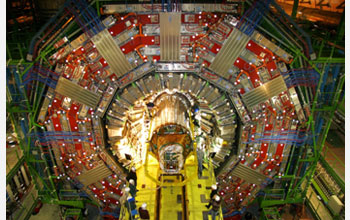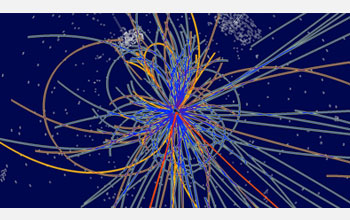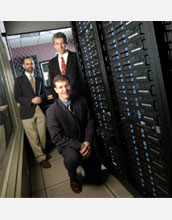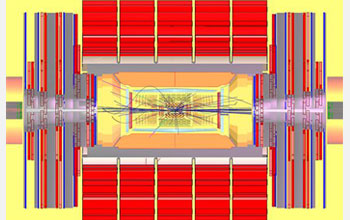|

All Images

Discovery
Physicists Gear Up for Huge Data Flow

Back to article | Note about images
 |
The Compact Muon Solenoid (CMS) detector at the European laboratory CERN weighs more than 12,000 tons. More than 700 scientists from 48 institutions in the United States participate in the CMS collaboration. For more information, visit: http://www.uscms.org/.
Credit: CERN |
Download the high-resolution JPG version of the image. (489 KB)
|
Use your mouse to right-click (or Ctrl-click on a Mac) the link above and choose the option that will save the file or target to your computer.
|
 |
A simulation of a proton-proton collision at the Large Hadron Collider (LHC). Detectors such as the Compact Muon Solenoid (CMS) will record the tracks created by hundreds of particles emerging from each collision. For more information, visit: http://www.uscms.org/ .
Credit: CERN |
Download the high-resolution JPG version of the image. (389 KB)
|
Use your mouse to right-click (or Ctrl-click on a Mac) the link above and choose the option that will save the file or target to your computer.
|
 |
University of Nebraska-Lincoln particle physicists Ken Bloom (left) and Aaron Dominguez (top) have teamed up with computer scientist David Swanson (bottom) to build a computing center for the benefit of scientists at their university and across the country.
Credit: University of Nebraska-Lincoln |
Download the high-resolution JPG version of the image. (829 KB)
|
Use your mouse to right-click (or Ctrl-click on a Mac) the link above and choose the option that will save the file or target to your computer.
|
 |
This track is an example of simulated data modeled for the Compact Muon Solenoid (CMS) detector on the Large Hadron Collider (LHC) at CERN, which will begin taking data later in 2008. This graphic shows a possible signature that a Higgs boson particle may leave in the detector. As the Higgs will be very short-lived, it cannot be observed directly, but rather, its production is inferred from the products of its decay.
Credit: CERN |
Download the high-resolution JPG version of the image. (196 KB)
|
Use your mouse to right-click (or Ctrl-click on a Mac) the link above and choose the option that will save the file or target to your computer.
|
|






